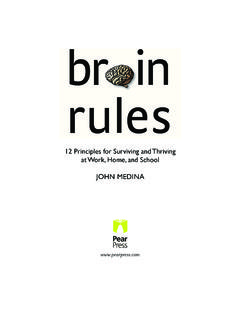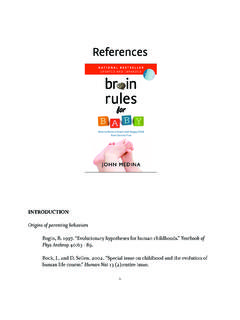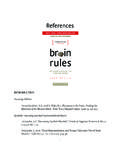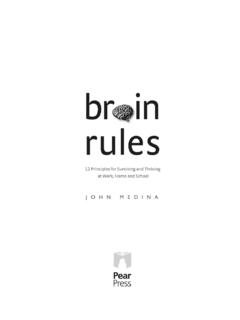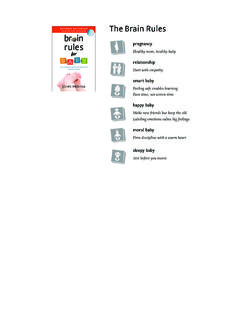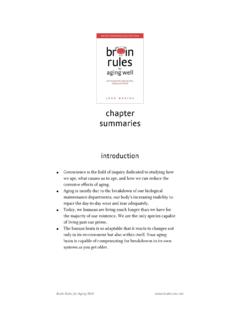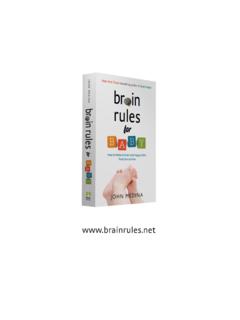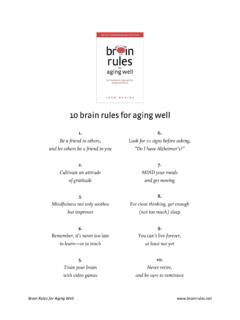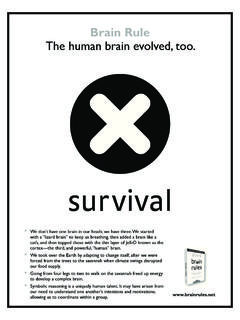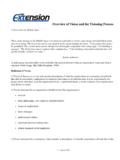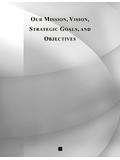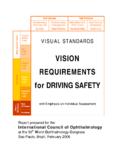Transcription of Exercise - Brain Rules
1 Exercise Rule #1 Exercise boosts Brain power. Our brains were built for walking 12 miles a day! To improve your thinking skills, move. Exercise gets blood to your Brain , bringing it glucose for energy and oxygen to soak up the toxic electrons that are left over. It also stimulates the protein that keeps neurons connecting. Aerobic Exercise just twice a week halves your risk of dementia. Survival Rule #2 The human Brain evolved, too. We don't have one Brain in our head we have three. We started with a lizard Brain to keep us breathing, then added a Brain like a cat s, and then topped those with the thin layer of Jell-O known as the cortex the third, and powerful, human Brain .
2 We took over the Earth by becoming adaptable to change, coming down from the trees to the savannah when the climate changed. Going from four legs to two to walk on the savannah freed up energy to develop a complex Brain . Symbolic reasoning the ability to perceive one thing as another is a uniquely human talent. It may have arisen from our need to understand one another s intentions and motivations, allowing us to coordinate within a group. Wiring Rule #3 Every Brain is wired differently. What you do and learn in life physically changes what your Brain looks like it literally rewires it.
3 The various regions of the Brain develop at different rates in different people. No two people s brains store the same information in the same way in the same place. We have a great number of ways of being intelligent, many of which don t show up on IQ tests. Attention Rule #4 People don t pay attention to boring things. The Brain s attentional spotlight can focus on only one thing at a time: no multitasking. We are better at seeing patterns and abstracting the meaning of an event than we are at recording detail. Emotional arousal helps the Brain learn.
4 Audiences check out after 10 minutes, but you can keep grabbing them back by telling narratives or creating events rich in emotion. Short-term memory Rule #5 Repeat to remember. The Brain has many types of memory systems. One type follows four stages of processing: encoding, storing, retrieving, and forgetting. Information coming into your Brain is immediately split into fragments that are sent to different regions of the cortex for storage. Most of the events that predict whether something learned also will be remembered occur in the first few seconds of learning.
5 The more elaborately we encode a memory during its initial moments, the stronger it will be. You can improve your chances of remembering something if you reproduce the environment in which you first put it into your Brain . Long-term memory Rule #6 Remember to repeat. Most memories disappear within minutes, but those that survive the fragile period strengthen with time. Long-term memories are formed in a two-way conversation between the hippocampus and the cortex, until the hippocampus breaks the connection and the memory is fixed in the cortex which can take years.
6 Our brains give us only an approximate view of reality, because they mix new knowledge with past memories and store them together as one. The way to make long-term memory more reliable is to incorporate new information gradually and repeat it in timed intervals. Sleep Rule #7 Sleep well, think well. The Brain is in a constant state of tension between cells and chemicals that try to put you to sleep and cells and chemicals that try to keep you awake. The neurons of your Brain show vigorous rhythmical activity when you re asleep perhaps replaying what you learned that day.
7 People vary in how much sleep they need and when they prefer to get it, but the biological drive for an afternoon nap is universal. Loss of sleep hurts attention, executive function, working memory, mood, quantitative skills, logical reasoning, and even motor dexterity. Stress Rule #8 Stressed brains do not learn the same way as non-stressed brains. Your body s defense system the release of adrenaline and cortisol is built for an immediate response to a serious but passing danger, such as a saber-toothed tiger. Chronic stress, such as hostility at home, dangerously deregulates a system built only to deal with short-term responses.
8 Under chronic stress, adrenaline creates scars in your blood vessels that can cause a heart attack or stroke, and cortisol damages the cells of the hippocampus, crippling your ability to learn and remember. Individually, the worst kind of stress is the feeling that you have no control over the problem you are helpless. Emotional stress has huge impacts across society, on children s ability to learn in school and on employees productivity at work. Sensory integration Rule #9 Stimulate more of the senses at the same time. We absorb information about an event through our senses, translate it into electrical signals (some for sight, others from sound, etc.)
9 , disperse those signals to separate parts of the Brain , then reconstruct what happened, eventually perceiving the event as a whole. The Brain seems to rely partly on past experience in deciding how to combine these signals, so two people can perceive the same event very differently. Our senses evolved to work together vision influencing hearing, for example which means that we learn best if we stimulate several senses at once. Smells have an unusual power to bring back memories, maybe because smell signals bypass the thalamus and head straight to their destinations, which include that supervisor of emotions known as the amygdala.
10 Vision Rule #10 Vision trumps all other senses. Vision is by far our most dominant sense, taking up half of our Brain s resources. What we see is only what our Brain tells us we see, and it s not 100 percent accurate. The visual analysis we do has many steps. The retina assembles photons into little movie-like streams of information. The visual cortex processes these streams, some areas registering motion, others registering color, etc. Finally, we combine that information back together so we can see. We learn and remember best through pictures, not through written or spoken words.
